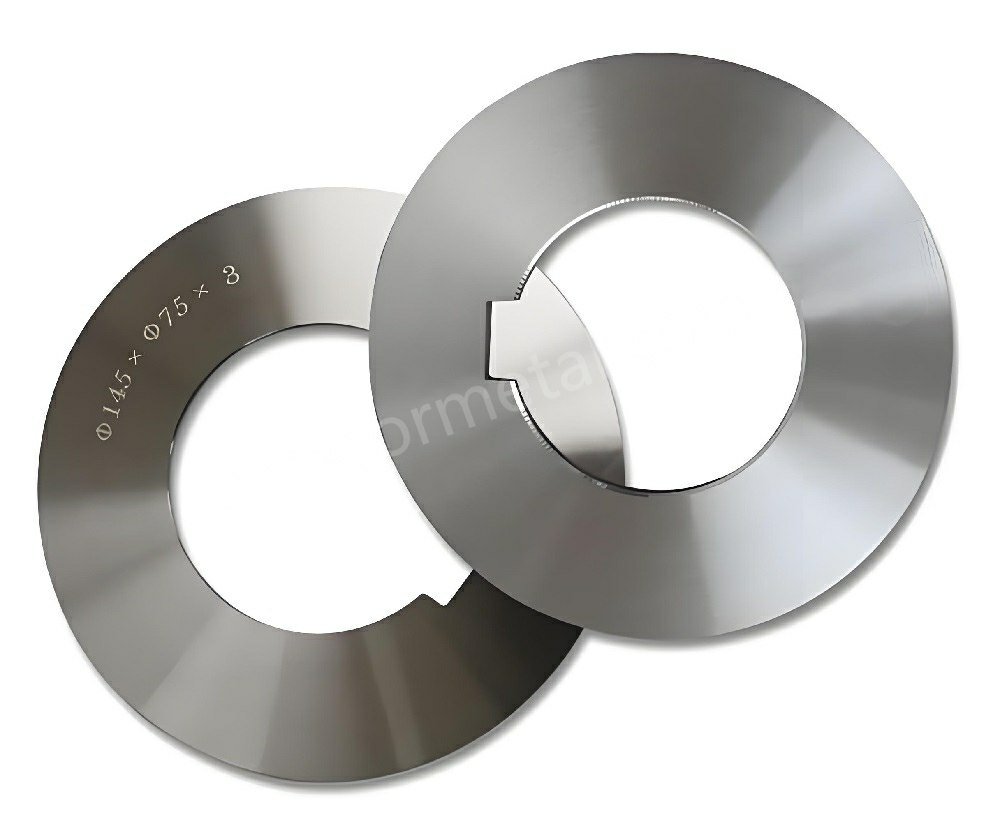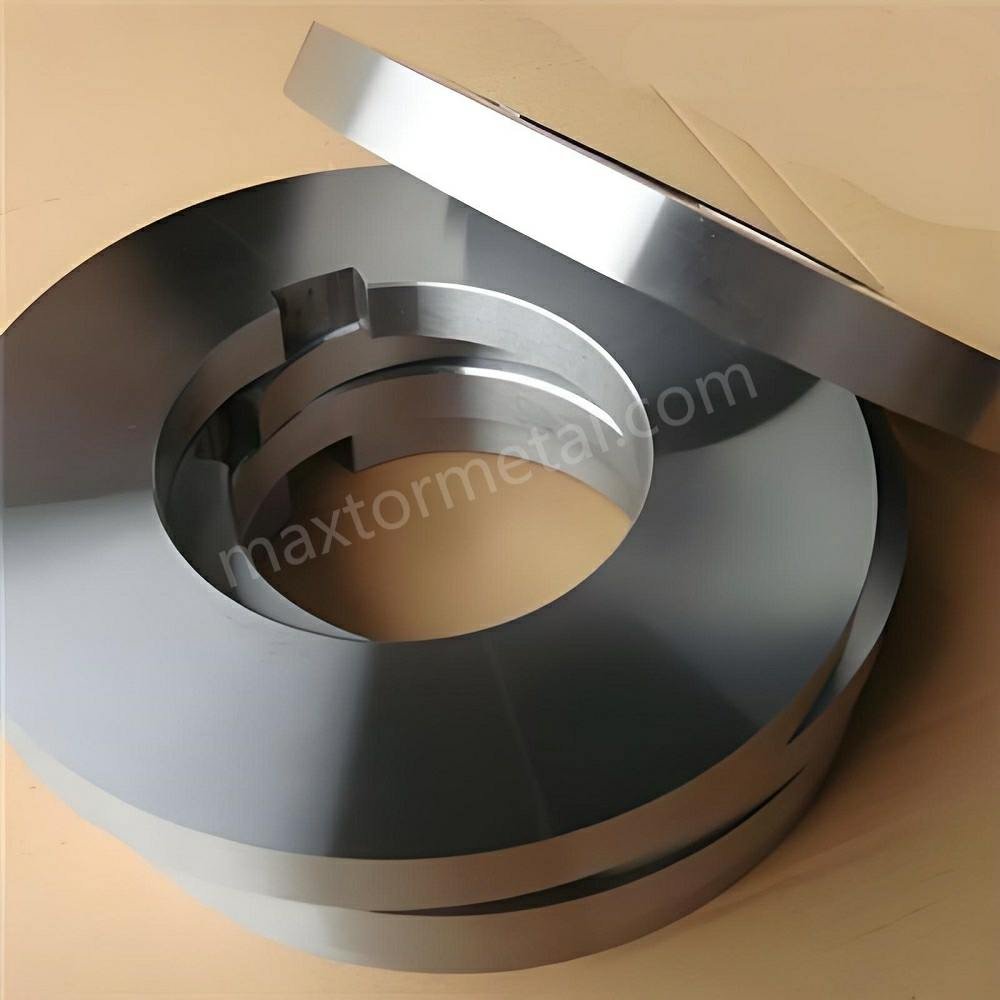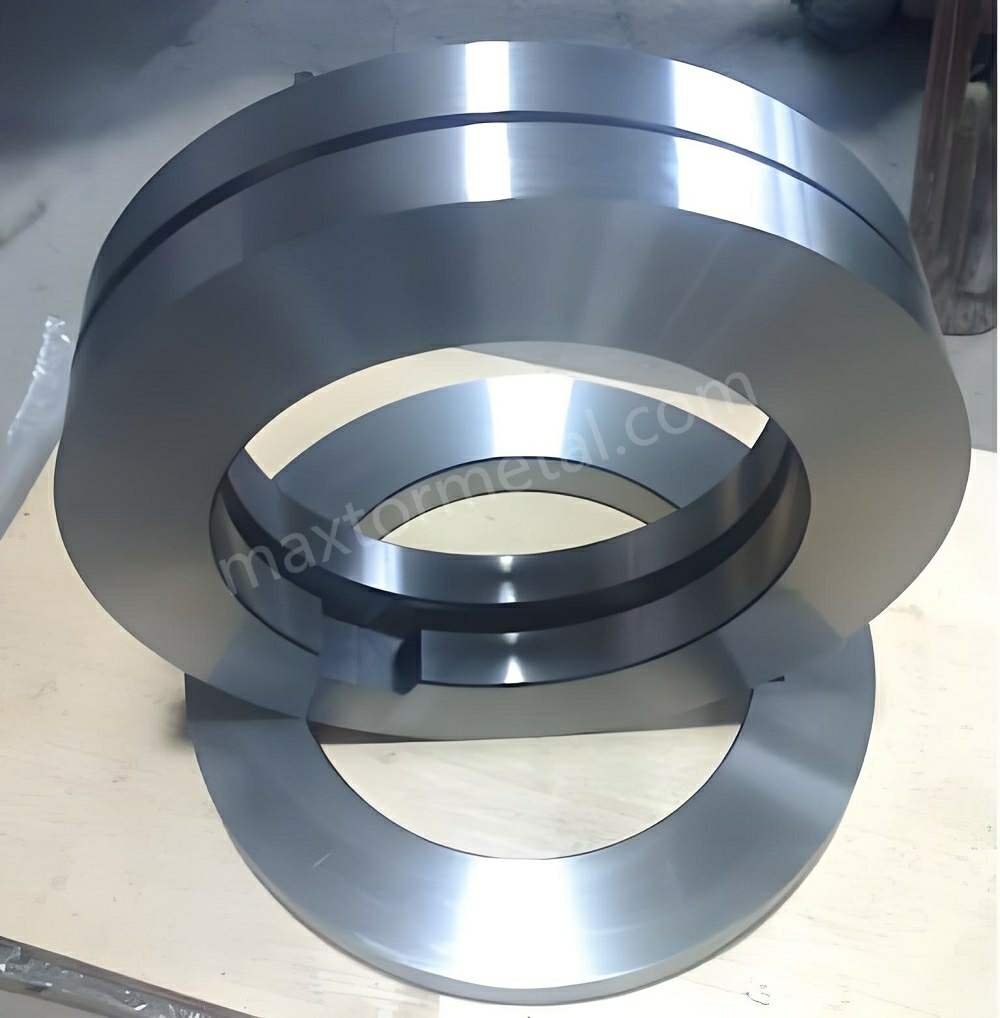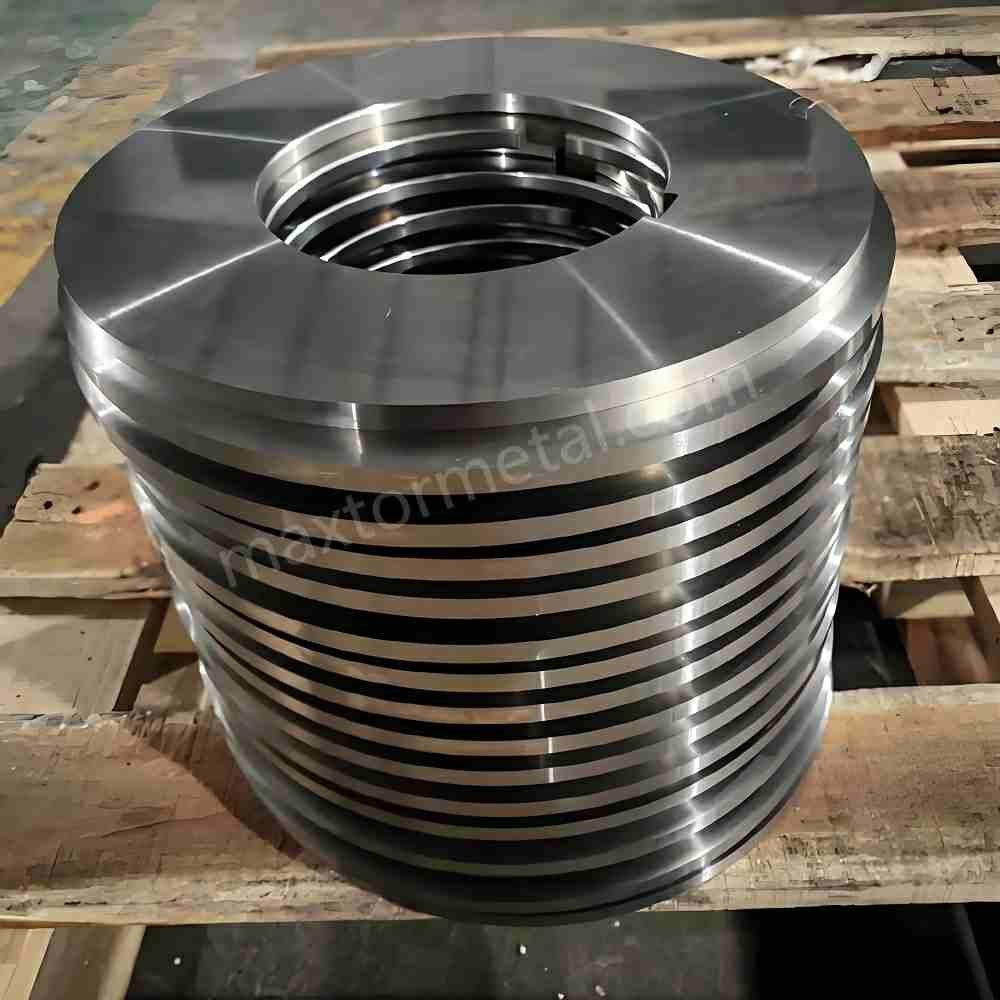
Choisir le bon lame de cisaillement à rouleaux est crucial. Il ne s'agit pas seulement de couper, mais de couper mieux. Une lame de cisaille à rouleau de qualité offre des bords plus lisses et un travail plus rapide. Sa durée de vie est également plus longue, ce qui signifie que vous devrez la remplacer moins souvent. Saviez-vous qu'utiliser les bons outils peut vous faire économiser jusqu'à 30% ? C'est une somme considérable ! Que vous optiez pour une lame personnalisée ou standard, choisir le bon modèle améliore la précision et minimise le gaspillage. Si vous ne savez pas par où commencer, contactez des fournisseurs de confiance comme Nanjing MetalIls peuvent vous aider à trouver la lame idéale. N'hésitez pas à Contact des experts : ils sont là pour vous aider.
Principaux points à retenir
- Choisir la bonne lame de cisaille à rouleaux permet d'optimiser la coupe. Une bonne lame peut réduire les coûts jusqu'à 30%.
- Les performances des lames varient selon les matériaux. Privilégiez les lames en carbure pour les travaux difficiles. L'acier allié est idéal pour les tâches quotidiennes.
- Les lames personnalisées répondent à des besoins de coupe spécifiquesIls sont plus précis et durent plus longtemps, ce qui en fait un investissement rentable.
- Prendre soin des lames est important. Nettoyez-les et huilez-les pour qu'elles durent plus longtemps et fonctionnent bien.
- Demandez conseil à des experts ou à des vendeurs de confiance. Leurs conseils vous aideront à choisir la lame la mieux adaptée à vos besoins.
Comprendre les lames de cisaillement à rouleaux
Que sont les lames de cisaillement à rouleaux ?
UN lame de cisaillement à rouleaux C'est un outil spécial pour couper des matériaux. Ces lames sont utilisées dans les industries exigeant des coupes nettes et précises. Elles fonctionnent en tournant contre une autre lame, tranchant le matériau. Imaginez des ciseaux, mais en beaucoup plus gros et plus résistants. Des industries comme la métallurgie, la papeterie et l'automobile font appel à ces lames.
Types de lames de cisaillement à rouleaux
Il existe différents types de Lames de Cisaille Rotative pour MétalChaque type est conçu pour une tâche spécifique. Voici une liste simple :
- Lames droites:Idéal pour les coupes droites dans le métal ou le papier.
- Lames circulaires:Idéal pour la découpe continue dans les textiles ou les plastiques.
- Lames Dentelées:Fabriqué à partir de matériaux résistants, offrant une meilleure adhérence et une meilleure précision.
- Lames Sur Mesure:Conçu pour des besoins spécifiques pour fonctionner parfaitement.
Le matériau de la lame influence son efficacité. Consultez ce tableau pour en savoir plus. matériaux de lame:
| Type de matériau | Caractéristiques |
|---|---|
| Acier à haute teneur en carbone et en chrome | Très dur, résiste à l'usure, tenace, fonctionne sur de nombreux matériaux. |
| Acier à outils allié | Ténacité et résistance à l'usure équilibrées, dure plus longtemps. |
| Acier rapide (HSS) | Reste affûté à grande vitesse, idéal pour les travaux difficiles. |
| Carbure | Extrêmement dur, résiste à l'usure, coupe les matériaux abrasifs, dure longtemps. |
Applications dans tous les secteurs
Lames de Cisaille Rotative pour Métal sont utilisés dans de nombreux secteurs. En voici quelques exemples :
| Industrie | Description de l'application | Résultat |
|---|---|---|
| Fabrication | Lames en acier robustes réduire les temps d'arrêt de 30% avec une meilleure durabilité. | Travaillez plus rapidement et gagnez du temps. |
| Fabrication Metal | Une étude a montré que les réglages des presses plieuses sont devenus plus rapides avec ces lames. | Gain de temps et réduction des coûts de main d'œuvre. |
Ces lames sont également utilisées dans l'emballage pour couper du carton ou du plastique. Leurs coupes précises et leur conception astucieuse en font des outils indispensables dans de nombreux secteurs.
Matériaux utilisés dans les lames de cisaillement à rouleaux
Le matériau d'un lame de cisaillement à rouleaux Cela influence son efficacité. Vous vous demandez peut-être pourquoi une lame est meilleure qu'une autre ? La réponse réside dans sa composition. Chaque matériau possède des propriétés uniques. Choisir la bonne lame dépend de ce que vous devez couper.
Matériaux courants et leurs propriétés
Voici une comparaison simple des matériaux utilisés dans ces lames :
| Propriété | Acier allié | Acier à outils | Acier rapide (HSS) |
|---|---|---|---|
| Dureté | HRC 57–59 (faiblement allié) | HRC 58–62 | HRC 60+ |
| Dureté | Très fort | Moyen | Inférieur (peut se casser facilement) |
| Résistance à l'usure | Bien | Excellent | Meilleur |
| Résistance à la chaleur | Moyen à élevé | Haut | Très élevé |
| Idéal pour | Plaques épaisses, acier inoxydable | Acier à haute teneur en carbone, plaques épaisses | Matériaux fins, coupe rapide |
| Coût | Moyen | Plus haut | Plus haut |
Chaque matériau a ses propres avantages. Par exemple, l'acier allié est résistant et idéal pour les tôles épaisses. L'acier rapide est parfait pour les travaux rapides, mais se casse plus facilement.
Composants clés qui font la différence
Le secret de la solidité d'une lame réside dans ses ingrédients. En voici quelques-uns importants :
- Chrome: Arrête la rouille et rend la lame plus dure.
- Tungstène:Ajoute de la résistance et maintient la lame tranchante sous la chaleur.
- Vanadium: Rend la lame plus résistante et dure plus longtemps.
- Molybdène:Aide la lame à rester solide en cas de forte chaleur.
Ces pièces fonctionnent ensemble pour fabriquer des lames tranchantes et durables.
Qu'est-ce que cela signifie pour vous ?
Choisir le bon matériau ne se résume pas à sa durée de vie. C'est aussi travailler plus vite et mieux. Pour couper des matériaux épais, l'alliage ou l'acier à outils sont un bon choix. Pour les travaux rapides, l'acier rapide peut vous faire gagner du temps. Connaître ces matériaux vous aidera à choisir la lame la mieux adaptée à vos besoins.
Facteurs clés pour choisir la meilleure lame de cisaille à rouleaux
Choisir le bon lame de cisaillement à rouleaux Ce n'est pas simple. Il faut réfléchir à de nombreux aspects pour s'assurer que cela réponde à vos besoins. Examinons cela étape par étape.
Matériau de la lame
Le matériau de la lame est très important. Chaque matériau a une résistance différente. Les connaître vous aidera à choisir la meilleure.
Types de matériaux
Les lames sont fabriquées à partir de différents matériaux, chacun adapté à des tâches spécifiques. Voici un aperçu rapide. caractéristiques clés à prendre en compte:
| Fonctionnalité | Ce que cela signifie |
|---|---|
| Force | Peut supporter la pression, la friction et la force sans se casser. |
| Fragilité | Montre avec quelle facilité la lame peut se fissurer sous l'effet du stress. |
| Dureté | Indique dans quelle mesure la lame résiste à la flexion ou aux dommages. |
| Poids | Affecte l'équilibre et la facilité d'utilisation de la machine. |
| Usinabilité | Montre à quel point il est simple de fabriquer ou d'ajuster la lame. |
| Soudabilité | Explique à quel point le matériau de la lame fonctionne bien avec le soudage. |
| Prix | Reflète le coût du matériel et sa disponibilité. |
| Résistance à la corrosion | Montre à quel point la lame évite la rouille ou les dommages causés par l'environnement. |
| Conductivité | Important pour les tâches de coupe impliquant de l'électricité statique. |
| Résistance à l'usure | Indique la durée de vie de la lame lorsqu'elle est utilisée fréquemment. |
| Température | Explique le bon fonctionnement de la lame dans des conditions très chaudes ou très froides. |
ConseilSi vous coupez des matériaux bruts, choisissez une lame très résistante à l'usure, comme le carbure. Pour la coupe générale, l'acier allié est robuste et abordable.
Caractéristiques de performance
Chaque matériau possède des qualités spécifiques. Par exemple, les lames en acier à haute teneur en carbone sont robustes et idéales pour les coupes difficiles. Les lames en acier rapide (HSS) restent affûtées même à haute température, ce qui les rend idéales pour les travaux rapides. Pour des résultats optimaux, choisissez toujours le matériau qui correspond à vos besoins.
Taille et épaisseur de la lame
La taille et l'épaisseur de la lame influencent sa performance de coupe et son adaptation à votre machine. Voyons pourquoi c'est important.
Trouver la bonne taille
Il est important d'adapter la taille de la lame à votre machine et au matériau à couper. Voici quelques points à retenir :
- Matériaux minces:Utilisez le mode 3 (écho à écho) pour une meilleure précision.
- Matériaux épais: Le mode 2 (interface vers le premier écho arrière) fonctionne mieux.
- Plage d'épaisseurLes jauges haute fréquence peuvent mesurer des matériaux fins jusqu'à 0,15 mm (0,006 pouce). Pour les matériaux plus épais, le mode 2 fonctionne jusqu'à 0,5 mm (0,020 pouce).
- Points mortsLes lames creuses peuvent présenter des zones gênantes pour les mesures. Choisissez le bon outil pour éviter les erreurs.
NoteConsultez toujours le guide de votre machine pour connaître les tailles de lame recommandées. Utiliser une taille inadaptée peut entraîner de mauvaises coupes ou endommager votre machine.
Impact de coupe
L'épaisseur de la lame influence la vitesse et la précision de vos coupes. Les lames fines sont idéales pour les travaux de précision. Les lames épaisses sont plus adaptées aux travaux lourds, mais nécessitent plus de puissance. Assurez-vous que votre machine est compatible avec cette taille de lame. Une bonne adaptation améliore la coupe et réduit l'usure de votre machine.
Capacité de coupe
À quel point un lame de cisaillement à rouleaux La coupe dépend du type de tranchant et de la vitesse. Examinons ces détails.
Styles de bordure
Le style de tranchant détermine la façon dont la lame coupe le matériau. Les styles courants sont :
- Bords droits:Idéal pour les coupes nettes dans le papier ou le métal fin.
- bords dentés:Idéal pour saisir et couper des matériaux résistants.
- bords circulaires:Parfait pour la découpe continue dans les plastiques ou les textiles.
Chaque style a sa propre utilisation, alors choisissez-en un en fonction de votre travail.
Vitesse de coupe
La vitesse de coupe influence votre rapidité de travail et la durée de vie de la lame. Une vitesse plus élevée permet de gagner du temps, mais peut user la lame plus rapidement, surtout sur des matériaux rugueux. Les recherches montrent que :
| Type d'étude | Résultats |
|---|---|
| Tests ANOVA | Le type et la profondeur de la lame affectent grandement la force de coupe et les résultats. |
| Comparaison des forces de conscription | Disques ondulés nécessaires 675 N (la plupart), disques crantés nécessaires 579 N (au moins). |
| Impact en profondeur | La force de coupe a triplé lorsque la profondeur est passée de peu profonde (291 N) à profonde (965 N). |
| Forces verticales | Les disques ondulés avaient 289 N (le plus élevé), les disques crantés avaient 164 N (le plus bas). |
| Succès de la coupe des résidus | J'ai mesuré dans quelle mesure les résidus ont été éliminés lors des tests. |
Conseil de proPour les matériaux épais ou résistants, utilisez une vitesse plus lente et un tranchant plus résistant. Cela prolongera la durée de vie de la lame et permettra des coupes plus nettes.

Besoins d'entretien
Soins réguliers
Prendre soin de votre lame de cisaillement à rouleaux Maintient la lame affûtée et utile. Un entretien régulier prévient les dommages et permet de réaliser des économies à long terme. Nettoyez toujours la lame après utilisation. La poussière et les résidus de matière peuvent s'accumuler et altérer sa capacité de coupe. Utilisez un chiffon doux ou une brosse pour l'essuyer. Évitez les produits chimiques agressifs qui pourraient endommager la surface de la lame.
La lubrification de la lame est également importante. Appliquez une fine couche d'huile pour empêcher la rouille et assurer son bon fonctionnement. Vérifiez l'absence de dommages, tels que fissures ou éclats, lors des inspections régulières. Résolvez les problèmes rapidement pour éviter des problèmes plus graves ultérieurement.
Conseil: Effectuez des contrôles d’entretien mensuels pour détecter rapidement les petits problèmes.
Techniques d'affûtage
Une lame émoussée fait de mauvaises coupes et vous ralentit. Affûtez votre lame de cisaillement à rouleaux Cela assure souvent son bon fonctionnement. Pour un résultat optimal, utilisez une pierre à aiguiser ou une meuleuse spéciale. Nettoyez d'abord soigneusement la lame, puis suivez ces étapes :
- Tenez la lame à l’angle droit (20 à 30 degrés).
- Faites glisser l'outil d'affûtage le long du bord en effectuant des mouvements fluides.
- Testez la lame en coupant quelque chose pour vérifier son tranchant.
Pour un affûtage expert, faites appel à des professionnels. Ils utilisent des outils précis pour fixer le tranchant de la lame sans l'abîmer.
Conseil de pro:N'affûtez pas trop, car cela peut affaiblir la lame et la faire s'user plus rapidement.
Considérations relatives aux coûts
Équilibrer qualité et prix
Trouver le bon équilibre entre qualité et prix est essentiel lors du choix d'un lame de cisaillement à rouleauxLes lames de haute qualité coûtent plus cher au départ, mais durent plus longtemps et fonctionnent mieux. Les lames moins chères sont plus économiques au départ, mais s'usent rapidement et doivent être remplacées fréquemment.
Lorsque vous réfléchissez au coût, tenez compte du matériau de la lame et de ses performances. Par exemple, les lames en carbure sont plus chères, mais résistent à l'usure et durent plus longtemps. Les lames en alliage d'acier sont moins chères et adaptées aux travaux de coupe courants.
Note:L’achat d’une lame adaptée à vos besoins peut vous faire économiser de l’argent en réduisant les déchets et en améliorant la vitesse de travail.
Investissement à long terme
Pensez à votre lame de cisaillement à rouleaux comme un achat à long terme. Investir davantage dans une lame robuste permet d'économiser sur les réparations et les remplacements. Des études montrent que des matériaux de haute qualité, comme l'acier rapide, réduisent les temps d'arrêt et augmentent la productivité.
Voici un aperçu simple des facteurs coûts-avantages :
| Aspect clé | Description |
|---|---|
| Performance vs. Prix | Les meilleurs matériaux coûtent plus cher mais offrent plus de valeur au fil du temps. |
| Durée de vie du matériau | Les lames robustes durent plus longtemps, vous les remplacez donc moins souvent. |
| Coût total de possession | Comprend l'achat, l'entretien et l'utilisation de la lame. |
| Épargne à long terme | De bonnes lames réduisent les déchets et rendent la coupe plus efficace. |
| Relations avec les fournisseurs | Les fournisseurs de confiance offrent une bonne qualité à des prix équitables. |
| Inventaire juste à temps | Une bonne gestion des stocks permet de réduire les coûts de stockage et de répondre à la demande. |
| Considérations relatives à la durabilité | Les matériaux écologiques aident l’environnement et permettent d’économiser de l’argent à long terme. |
Choisir une lame durable et performante vous permet d'économiser de l'argent et d'améliorer votre processus de travail. Établir de bonnes relations avec vos fournisseurs vous permet également d'obtenir des matériaux de qualité à des prix plus avantageux.
Conseil:Concentrez-vous sur le coût total de possession, et pas seulement sur le prix, pour faire un choix plus judicieux.

Le rôle de la personnalisation dans les lames de cisaillement à rouleaux
Pourquoi la personnalisation est importante
Tous les outils de coupe ne conviennent pas à tous les travaux. Chaque tâche a ses propres besoins, et c'est là que la personnalisation est essentielle. lame de cisaillement à rouleaux Peut grandement améliorer votre travail. Il garantit que la lame répond parfaitement à vos besoins de coupe, que ce soit pour des matériaux tendres ou des métaux durs.
Utiliser une lame ordinaire pour un travail spécifique peut souvent poser problème. Vous risquez de mauvaises coupes, de gaspiller des matériaux, voire d'endommager votre machine. Lames Sur Mesure Nous résolvons ces problèmes en répondant à vos besoins spécifiques. Cela permet d'obtenir de meilleurs résultats, un travail plus rapide et des délais réduits.
Conseil:Si vous manipulez des matériaux délicats ou des tâches de coupe difficiles, une lame personnalisée est le meilleur moyen d'obtenir des résultats précis et stables.
Avantages des lames de cisaillement à rouleaux personnalisées
Pourquoi choisir une lame sur mesure ? Elle offre bien plus que la simple efficacité. Voici ce que vous y gagnez :
- Parfaitement adapté à vos besoinsLes lames sur mesure sont fabriquées pour s'adapter à votre machine et à votre matériau. Cela permet une coupe plus fluide et réduit l'usure de vos outils.
- Qualité de coupe améliorée:Ils donnent des coupes plus nettes et plus précises, réduisant les déchets et améliorant votre produit.
- Durabilité améliorée:Les lames personnalisées sont fabriquées avec des matériaux qui durent plus longtemps dans vos conditions de travail.
- Rapport coût-efficacité:Bien qu'ils puissent coûter plus cher au départ, ils permettent d'économiser de l'argent au fil du temps en durant plus longtemps et en réduisant les temps d'arrêt.
- La flexibilitéBesoin d'une lame pour un travail spécifique ? Nos lames sur mesure peuvent venir à bout des tâches les plus difficiles.
Des entreprises comme Nanjing Metal Nous sommes experts dans la fabrication de lames sur mesure. Forts de 18 ans d'expérience, nous sommes reconnus pour nos solutions sur mesure de haute qualité. Notre équipe qualifiée garantit que chaque lame répond aux normes les plus strictes.
Conseil de pro:Travailler avec des fabricants de confiance comme Nanjing Metal vous garantit d'obtenir une lame à la fois efficace et fiable.
Comment personnaliser votre lame
Personnaliser un lame de cisaillement à rouleaux C'est plus facile qu'il n'y paraît. Suivez ces étapes pour commencer :
- Identifiez vos besoins: Réfléchissez à ce que vous devez couper. Quels matériaux utiliserez-vous ? Quelle précision de coupe faut-il accorder ?
- Choisissez le bon fabricant: Trouvez une entreprise expérimentée dans les lames sur mesure. Nanjing Metal, par exemple, possède des années d'expertise dans ce domaine.
- Discuter des spécificationsDiscutez avec le fabricant de la taille, du matériau et du type de tranchant de la lame. Définissez clairement vos besoins pour obtenir les meilleurs résultats.
- Testez la lame:Une fois la lame fabriquée, essayez-la. Cela vous permettra de vous assurer de son bon fonctionnement et d'apporter des modifications.
- Maintenir une communication régulière:Restez en contact avec le fabricant pour obtenir de l'aide et des conseils pour garder la lame en bon état.
La personnalisation ne se limite pas à la fabrication d'une lame : il s'agit de créer un outil parfaitement adapté à votre travail. Une lame sur mesure est un investissement pour de meilleurs résultats et un fonctionnement plus fluide.
Appel à l'action:Vous souhaitez améliorer vos outils de coupe ? Contactez les experts de Nanjing Metal dès aujourd'hui. Grâce à leur savoir-faire et à leur souci de la qualité, ils vous aideront à concevoir la lame idéale pour vos besoins.
Erreurs courantes à éviter
Choisir la mauvaise lame pour le matériau
Utiliser une lame inadaptée peut entraîner de mauvaises coupes et des dommages. Chaque matériau a des besoins différents, et les lames doivent y correspondre. Une lame trop dure peut se fissurer ou se casser sur des matériaux tendres. Une lame trop tendre s'use rapidement sur des matériaux durs.
Voici un tableau simple des problèmes de lame courants :
| Type de problème | Ce qui se produit |
|---|---|
| Fissures du noyau | La lame se plie ou se casse lorsqu'elle est trop dure pour le matériau. |
| Perte de segment | La lame se tord ou se bloque parce que le matériau ne lui convient pas. |
| Fissures de segment | Des fissures apparaissent lorsque la lame est trop dure pour le travail. |
Pour éviter ces problèmes, choisissez une lame adaptée à votre matériau. En cas de doute, demandez conseil à votre fournisseur ou fabricant.
Sauter l'entretien
Ne pas entretenir votre lame peut l'user plus rapidement. La poussière et la saleté s'accumulent, rendant la lame moins tranchante. Négliger l'entretien peut également entraîner des accidents ou des pannes.
Voici quelques conseils pour garder votre lame en bon état :
- Nettoyez et vérifiez souvent votre lame pour éviter les problèmes.
- Notez les contrôles de maintenance pour détecter les problèmes à un stade précoce.
- Lubrifiez la lame pour arrêter la rouille et la maintenir en bon état de fonctionnement.
Un entretien régulier préserve la sécurité et la longévité de votre lame. Un petit effort permet d'économiser de l'argent et d'éviter les accidents.
Ignorer la compatibilité des équipements
Une lame inadaptée à votre machine ne fonctionnera pas correctement. Utiliser une lame de taille ou d'épaisseur inappropriée peut entraîner des blocages ou des coupes irrégulières. Par exemple, une lame épaisse risque de se bloquer, tandis qu'une lame fine risque de ne pas couper correctement.
Avant d'acheter une lame, consultez le guide de votre machine pour connaître les dimensions et l'épaisseur. Si vous remplacez votre machine, assurez-vous que vos lames sont toujours compatibles. Prendre le temps de vérifier permet d'économiser de l'argent et d'éviter les dommages.
Conseil:Si vous n'êtes pas sûr, lisez le manuel de votre machine ou demandez de l'aide au fabricant.
Privilégier le coût à la qualité
Choisir le moins cher lame de cisaillement à rouleaux Cela peut paraître judicieux. Économiser de l'argent au départ, c'est bien, non ? Mais les lames moins chères coûtent souvent plus cher par la suite.
Les lames bon marché s'usent rapidement. Vous les remplacerez plus souvent, ce qui s'accumule. On dit souvent qu'acheter bon marché, c'est acheter deux fois. Des lames de mauvaise qualité peuvent entraîner des coupes irrégulières et un gaspillage de matériaux. Elles peuvent même endommager votre équipement, ralentir le travail et frustrer votre équipe.
Au lieu de vous concentrer sur le prix, pensez au coût total. Cela inclut la durée de vie de la lame et son entretien. Une lame de qualité coûte plus cher au départ, mais elle dure plus longtemps et fonctionne mieux. C'est comme acheter une voiture fiable : elle permet d'économiser sur les réparations et reste utile pendant des années.
La qualité des lames influence également la satisfaction client. Des coupes nettes et précises améliorent vos produits et fidélisent vos clients. Des lames de mauvaise qualité peuvent engendrer des produits de mauvaise qualité, ce qui peut faire fuir les clients.
Comment choisir judicieusement ? Effectuez une analyse coûts-avantages. Ne vous limitez pas au prix et pensez aux performances. La lame réduira-t-elle les temps d'arrêt ? Accélérera-t-elle le travail ? Ce sont des questions importantes à se poser.
ConseilInvestir davantage dans la qualité est plus judicieux à long terme. Une lame durable améliore la productivité et réduit les coûts futurs.

Conseils pour choisir la meilleure lame de cisaille à rouleaux
Demandez aux professionnels
Choisir le bon lame de cisaillement à rouleaux Cela peut être délicat. Les experts connaissent parfaitement les matériaux, les tailles et les méthodes de coupe des lames. Ils peuvent vous aider à choisir la lame la mieux adaptée à vos besoins.
Contactez des fournisseurs ou des fabricants de confiance pour obtenir des conseils. Les entreprises offrant un service client de qualité peuvent vous informer sur les nouvelles technologies de lames. En cas de doute sur l'ajustement ou les performances d'une lame, n'hésitez pas à poser des questions. Des experts peuvent également vous donner des conseils d'entretien et de formation pour prolonger la durée de vie de votre lame.
Conseil: Travaillez avec un fournisseur fiable. Ses conseils amélioreront vos résultats de coupe.
Comparer les options
Les lames ne se valent pas toutes. Comparer les marques et leurs caractéristiques vous aidera à trouver la bonne. Privilégiez les marques réputées pour leurs lames robustes et précises. Consultez les avis pour découvrir leurs performances en conditions réelles.
Vérifiez les caractéristiques comme le matériau, le style de tranchant et la vitesse de coupe. Certaines lames sont adaptées aux tâches difficiles, tandis que d'autres sont plus adaptées aux coupes de précision. Pensez également au rangement et aux pièces de rechange. Les marques proposant ces options peuvent vous éviter des problèmes plus tard.
Conseil de pro: Ne choisissez pas la lame la moins chère. Dépenser un peu plus peut vous faire économiser de l'argent à long terme.
Envisagez des lames personnalisées
Les lames standard ne sont pas toujours adaptées aux travaux spécifiques. Les lames sur mesure sont conçues pour répondre précisément à vos besoins. Vous pouvez choisir la taille, le matériau ou le type de tranchant adapté à votre tâche.
Tout d'abord, déterminez ce que vous devez couper. S'agit-il d'un matériau tendre ou dur ? Ensuite, discutez de vos besoins avec un fabricant. Des entreprises comme Nanjing Metal fabriquent des lames sur mesure parfaitement adaptées à votre machine et à votre matériau.
Testez la lame avant de l'utiliser pleinement pour vous assurer de son bon fonctionnement. Contactez le fabricant pour obtenir des conseils afin d'optimiser les performances de votre lame.
Appeler:Les lames personnalisées coûtent plus cher au départ, mais permettent d'économiser de l'argent en durant plus longtemps et en fonctionnant mieux.
Testez avant l'achat
Avant d'acheter une lame de cisaille à rouleaux, testez-la pour gagner du temps, économiser de l'argent et éviter toute frustration. Considérez cela comme un essai pour vous assurer que la lame répond à vos attentes. Voici comment procéder :
- Inspecter la lameCommencez par examiner attentivement. Vérifiez l'absence de défauts visibles, tels que des fissures, des éclats ou des bords irréguliers. Une lame présentant des imperfections pourrait ne pas fonctionner correctement, voire endommager votre équipement.
- Demander une coupe d'essaiDemandez une démonstration pratique au fournisseur. Observer la lame en action vous donnera une idée précise de sa précision et de sa vitesse de coupe. Vous verrez comment elle gère le matériau à couper.
- Vérifiez la qualité avec des expertsEn cas de doute sur l'authenticité d'une lame, consultez un expert. Il pourra vous aider à repérer les contrefaçons et à confirmer la qualité de la lame. Cette étape est particulièrement utile pour les lames coûteuses ou personnalisées.
- Évaluer les performances: Observez attentivement le comportement de la lame pendant le test. Coupe-t-elle facilement ? Son tranchant est-il suffisamment tranchant ? Un test rapide peut vous indiquer si la lame vaut l'investissement.
ConseilTestez toujours la lame sur le même matériau que celui que vous utiliserez lors de vos opérations. Cela garantit des résultats précis et adaptés à vos besoins.
Tester avant l'achat ne consiste pas seulement à éviter les mauvais achats. Il s'agit de trouver l'outil idéal pour votre travail. Un petit effort en amont peut vous permettre d'obtenir de meilleures coupes, des lames plus durables et un fonctionnement plus fluide. Alors, ne sautez pas cette étape ! Le jeu en vaut la chandelle !
Choisir la bonne lame de cisaille à rouleaux est essentiel. Choisissez une lame adaptée à votre matériau et à vos tâches de coupe. Assurez-vous qu'elle soit robuste et envisagez des options personnalisées pour les travaux spécifiques. Ne négligez pas l'entretien ou n'utilisez pas la bonne lame. Demandez conseil à des experts et privilégiez la qualité, pas seulement le prix. Une bonne lame permet de gagner du temps, de réduire les déchets et d'améliorer la performance. Des choix judicieux dès maintenant garantissent de meilleurs résultats plus tard.

FAQ
Quel est le matériau le plus résistant pour les lames de cisaillement à rouleaux ?
Le carbure est le matériau le plus résistant. Très dur, il ne s'use pas facilement. Il est donc idéal pour couper des matériaux rugueux. Si vous avez besoin d'une lame durable pour les travaux difficiles, le carbure est le meilleur choix.
Conseil:Pour les tâches quotidiennes, l’acier allié est solide et abordable.
À quelle fréquence dois-je affûter ma lame de cisaille à rouleau ?
Aiguisez votre lame lorsque les coupes deviennent rugueuses ou que les performances diminuent. Des contrôles réguliers permettent de détecter rapidement tout émoussement. Si vous utilisez la lame fréquemment, affûtez-la toutes les deux ou trois semaines. Pour une utilisation plus légère, un affûtage tous les deux ou trois mois suffit.
Conseil de pro: Ne pas trop affûter, car cela peut affaiblir la lame.
Une lame peut-elle fonctionner pour tous les matériaux ?
Non, ce n'est pas possible. Chaque matériau nécessite un type de lame différent. Par exemple, les lames dentées sont plus adaptées aux matériaux durs. Les lames droites sont idéales pour les coupes nettes dans le papier ou le métal fin. Utiliser une lame inadaptée peut endommager le matériau et la lame.
Comment puis-je vérifier si une lame convient à ma machine ?
Consultez le manuel de votre machine pour connaître la taille et l'épaisseur de la lame. En cas de doute, renseignez-vous auprès du fabricant ou du fournisseur. L'utilisation d'une lame inadaptée peut entraîner des blocages, de mauvaises coupes, voire endommager votre machine.
Note: Vérifiez toujours la compatibilité avant d'acheter une nouvelle lame.
Les lames personnalisées sont-elles un bon choix ?
Oui, les lames sur mesure sont idéales pour des besoins de coupe spécifiques. Elles sont conçues pour s'adapter parfaitement à votre machine et à vos matériaux. Cela améliore la précision de coupe et prolonge la durée de vie de la lame. Bien qu'elles soient plus coûteuses au départ, elles permettent de réaliser des économies en réduisant les déchets et les temps d'arrêt.
Appeler:Contactez des fabricants de confiance comme Nanjing Metal pour des lames personnalisées de qualité supérieure.
Voir aussi
Conseils essentiels pour choisir le bon couteau de pelletisation


